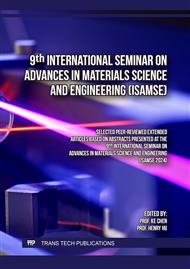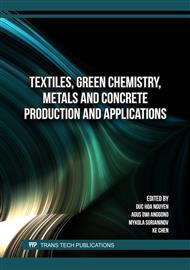[1]
T H Li, H Ye, J M Jin, et al. Electric-field strengthening uranium extraction from seawater assisted by nanofiltration membranes with sieving-adsorption properties [J]. Journal of Membrane Science, 2024, 693.
DOI: 10.1016/j.memsci.2023.122334
Google Scholar
[2]
Dominika K, Łukasz S, Krzysztof G. Polyamide Noncoated Device for Adsorption-Based Microextraction and Novel 3D Printed Thin-Film Microextraction Supports. [J]. Analytical chemistry, 2022, 94(6).
DOI: 10.1021/acs.analchem.1c03672.s001
Google Scholar
[3]
N Ma, J Zhou, X Q Wang, et al. Oil-removal efficiency of cascade coalescence process with absorbent cotton fibers [J]. 2023, 43(5): 620-625.
Google Scholar
[4]
Milovanovic S, Markovic D, Castvan J I, et al. Cornstarch aerogels with thymol, citronellol, carvacrol, and eugenol prepared by supercritical CO2-assisted techniques for potential biomedical applications [J]. Carbohydrate Polymers, 2024, 331.
DOI: 10.1016/j.carbpol.2024.121874
Google Scholar
[5]
Obek A C, Saptoro A, Tiong T N A, et al. Empirical correlations of drug-and plant-based bioactive compound solubility in supercritical CO2: A comparative evaluation study [J]. Fluid Phase Equilibria, 2024, 580.
DOI: 10.1016/j.fluid.2024.114061
Google Scholar
[6]
S L Wei, J H Xie, J M Zhang, et al. Green preparation of poly (butylene succinate-co-butylene terephthalate) foam with tunable degradability and mechanical properties by supercritical CO2 [J]. Polymer Degradation and Stability, 2024, 223.
DOI: 10.1016/j.polymdegradstab.2024.110732
Google Scholar
[7]
Sun H, Guo Q, Wang J, et al. 3D Printing of Hierarchically Porous Polyetherimide for Enhanced Oil Adsorption and Oil/Water Separation via Supercritical CO2 Foaming [J]. Advanced Materials Technologies, 2024, 9(8).
DOI: 10.1002/admt.202301756
Google Scholar
[8]
P. J C, Paula M R, S. I F, et al. Optimization of Oil Recovery from Japonica Luna Rice Bran by Supercritical Carbon Dioxide Applying Design of Experiments: Characterization of the Oil and Mass Transfer Modeling [J]. ChemEngineering, 2022, 6(4).
DOI: 10.3390/chemengineering6040063
Google Scholar
[9]
Y C Ma, H D Zheng, X Q Xiong, et al. Dyeing of Linen Fabrics in Supercritical CO2; Using a Reverse Micellar System with Ionic Liquid Domains [J]. Journal of Natural Fibers, 2023, 20(2).
DOI: 10.1080/15440478.2023.2222555
Google Scholar
[10]
Z J Wei, L Lin, J R Ni. A kinetic model of Rhubarb anthraquinones extraction by supercritical CO2 fluid. Chin. J. Chem. Eng. 2006, 2006(2):197202.
Google Scholar
[11]
Y F Li, Y Xiu, Y Z Yang, et al. Kinetics and Thermodynamics Characteristics of Supercritical Carbon Dioxide Extraction Sterol from Korean Pine Needles. Linye Kexue. 2018, 54(04).
Google Scholar



